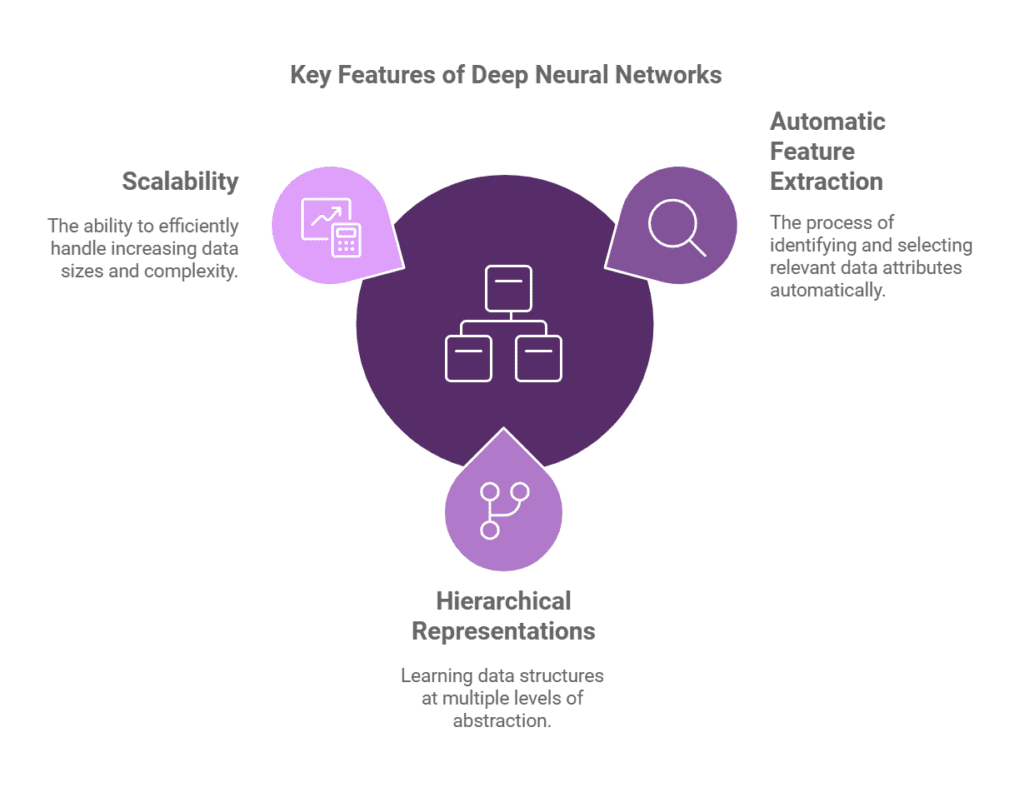What is Deep Neural Network?
A Deep Neural Network (DNN) is a type of artificial neural network that consists of multiple layers designed to model complex patterns in data. By utilizing deep learning networks, DNNs are capable of automatically extracting features and understanding intricate relationships within vast datasets, making them essential in tasks such as image recognition, natural language processing, and predictive analysis.
How Does the Deep Neural Network Operate or Function?
A Deep Neural Network (DNN) operates using a multi-layered architecture that enables it to learn patterns and make predictions. Here’s how it functions:
- Input Layer: Accepts raw data (e.g., images, text, or numbers) for processing.
- Hidden Layers: Consist of multiple neural network layers that apply transformations, detect features, and refine outputs progressively.
- Weights and Activation Functions: Weighted connections and non-linear activation functions (like ReLU, Sigmoid) enable the model to learn intricate relationships.
- Backpropagation: During training, DNNs minimize errors using DNN algorithms like gradient descent to update the weights.
- Output Layer: Produces predictions, classifications, or other outputs based on learned patterns.
Key Features:
- Automatic feature extraction.
- Ability to learn hierarchical representations of data.
- Scalability for large, high-dimensional datasets.
The result is highly accurate models that excel in complex tasks such as computer vision, speech recognition, and machine translation.

Common Uses and Applications of Deep Neural Networks
Deep Neural Networks (DNNs) have revolutionized multiple industries, driving advancements in artificial intelligence and automation. Here are some prominent applications:
- Image Recognition: Used in facial recognition, autonomous vehicles, and medical imaging analysis.
- Natural Language Processing: DNN models power chatbots, conversational AI, and real-time translation systems.
- Healthcare: Analyze medical data to detect diseases, predict outcomes, and assist in personalized treatment plans.
- Finance: Detect fraudulent activities, predict stock trends, and automate credit risk assessments.
- Recommendation Systems: Platforms like Netflix, Amazon, and Spotify use DNNs to personalize user experiences.
- Autonomous Systems: In self-driving cars, DNNs process real-time sensor data for navigation and decision-making.
By leveraging neural net architectures, DNNs enable smarter solutions to real-world problems.
What are the Advantages of Deep Neural Networks?
Deep Neural Networks offer significant advantages in solving complex problems across various domains:
- High Accuracy: DNNs achieve superior performance by learning from large datasets.
- Automated Feature Extraction: Eliminates the need for manual feature engineering.
- Handling Complex Data: Effective at managing high-dimensional data, including images, audio, and text.
- Scalability: Capable of processing massive datasets efficiently.
- Versatility: Applicable to a wide range of tasks, including classification, regression, and generation.
- Improved Generalization: Prevents overfitting with techniques like dropout and batch normalization.
These benefits make DNN algorithms indispensable for AI researchers and machine learning engineers.
Are There Any Drawbacks or Limitations of Deep Neural Networks?
While Deep Neural Networks are highly powerful, they come with a few limitations:
- High Computational Requirements: Training deep learning networks requires substantial computational resources.
- Data Dependency: DNNs perform best with large, high-quality datasets, which can be challenging to obtain.
- Interpretability: DNN models often act as black boxes, making it difficult to interpret decisions.
- Overfitting: Without proper regularization, DNNs may overfit to training data.
These limitations require careful optimization and management of neural net architectures during development.
How Does Deep Neural Networks Compare to Traditional Machine Learning?
- Feature Learning: Traditional machine learning requires manual feature extraction, whereas DNNs learn features automatically.
- Complexity Handling: DNNs excel at non-linear relationships and large, unstructured datasets, unlike simpler algorithms.
- Performance: DNNs achieve higher accuracy in tasks like image classification and NLP compared to traditional models.
Future Trends for Deep Neural Networks
The future of Deep Neural Networks includes several promising advancements:
- Unsupervised Learning: Enhanced ability to learn without labeled data.
- Hybrid Architectures: Combining DNN models with other approaches for improved performance.
- Edge AI: Optimized DNNs running on edge devices for real-time applications.
- Explainability: Improvements in making DNN decisions more transparent and interpretable.

These advancements will make deep learning networks more adaptable and efficient.
Best Practices for Using Deep Neural Networks
To effectively implement Deep Neural Networks, follow these best practices:
- Data Preprocessing: Normalize and clean data for optimal input.
- Architecture Design: Choose the appropriate number of neural network layers and activation functions.
- Regularization: Apply techniques like dropout to prevent overfitting.
- Hyperparameter Tuning: Optimize learning rates, batch sizes, and layer depths for the best results.
- Evaluation: Validate the model using test data to ensure generalization.
Step-by-Step Instructions for Implementing a Deep Neural Network
- Define the Problem: Specify the type of task (e.g., classification, regression).
- Collect and Prepare Data: Clean, normalize, and split the data into training, validation, and test sets.
- Design the Architecture: Choose a suitable number of neural network layers and activation functions.
- Train the Model: Use backpropagation and optimization algorithms like gradient descent.
- Validate and Evaluate: Assess performance using metrics like accuracy, loss, or F1-score.
- Fine-Tune the Model: Adjust hyperparameters to improve results.
- Deploy the Model: Integrate the trained model into the desired application.
Frequently Asked Questions
Q: What is a Deep Neural Network?
A: A Deep Neural Network (DNN) is a multi-layered artificial neural network designed to model complex data patterns.
Q: What are the benefits of DNN models?
A: DNN models provide high accuracy, automated feature learning, and scalability for complex tasks.
Q: How many layers does a Deep Neural Network have?
A: A DNN typically consists of an input layer, multiple hidden layers, and an output layer.
Q: What are common applications of DNNs?
A: Deep neural networks are used in image recognition, NLP, recommender systems, and autonomous systems.
Q: How do DNNs improve AI capabilities?
A: By automatically extracting features and handling large datasets, DNN algorithms significantly enhance AI performance.







